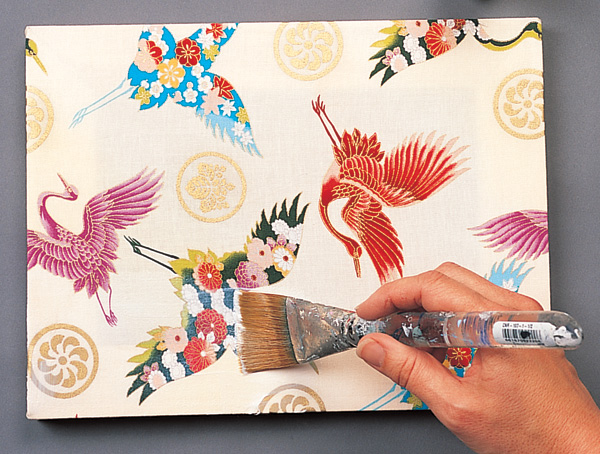as an artist what kind of paint should i use to paint a car art
Editor's Note: This painting advice comes to yous from Nancy Reyner'southward book Acrylic Revolution.

You lot Tin can Paint on Annihilation: Painting Substrates for Acrylic
Acrylic can be painted on merely about any support. Select among the many choices in this section for convenience, longevity and aesthetics.

1. Canvas
Canvass is ordinarily used as a painting surface and offers many advantages: it'due south absorbent, has a wonderful fabric texture, is lightweight and portable. Canvas supports comes in three types: unstretched, stretched and commercially made canvas boards. Canvas paper also comes in pads, simply canvass newspaper feels very slick, not at all like real canvass cloth.Stretching it yourself takes practice. You'll need wood stretcher bars, a staple gun and stretcher pliers. Wrap the canvas around the bars and tack it down in the back, pulling information technology tightly each time. First from the center and piece of work outward. Stretched canvases can be purchased in standard sizes, or custom-made by your art store or framer. Those that are mass-produced with a machine can sometimes price about the same or less than supplies for stretching it yourself.

2. Paper and Cardboard
Paper and cardboard are great support choices if you are a beginner or just desire to experiment. Both are economical and easy to find. Both take absorbent surfaces that brand washes and over-watered acrylic techniques possible. Select acid-costless papers or cardboard, which are more archival and will not take impurities that might stain through into your painting.

3. Wood and Composite Panels
Forest is a slap-up back up for paintings, especially for thick applications of pigment and other techniques that require a rigid, sturdy support. In that location are many types of natural wood bachelor, as well equally composites such every bit Masonite, high-density fiber board (HDFB) and medium-density cobweb board (DFB). Birch makes great thin, lightweight console for large paintings.Wood has many impurities, resins and other natural elements that may seep through into paint layers, causing stains and yellowing. Ever clean the surface first, declension it with a stain sealer, then prime number before painting. Composites are strong and have the feel of wood but don't accept a natural wood grain. Some other type of composite product is particleboard, which is made of pressured sawdust. Moisture will crusade the surface of particleboard to swell, so sand it subsequently the first few coats of sealer and primer to smooth out the crude surface, and it should remain smooth for subsequent coats and painting.

four. Patterned Material
I love browsing in fabric stores to go ideas for colors, patterns and textures. Sometimes I purchase small pieces of fabric only to hang effectually my studio for inspiration. A fun technique is to take your favorite fabric and use that equally the starting surface to begin a painting. No need to stare at that white canvas with fearfulness. Get a bound-get-go by commencement your painting with colors and patterns already there!

5. Silk
If y'all desire to pigment on silk and hope to keep the fabric soft and freely flowing to use every bit a banner, fabric installation or wearable art, fluid acrylics offer a more than stable alternative than fabric dyes. Dye works well on silk, but is not as lightfast and stable as acrylic. This technique demonstrates how to employ acrylic on silk for durable, lightfast, washable color while maintaining the softness of the textile. This technique may be used on fabrics other than silk.

half-dozen. Metal
The two issues of concern for preparing a metal support are adhesion and rust control. This technique works best for ferrous metals like steel and will provide a long-lasting rustproof support for indoor or outdoor utilize, suitable for coating with acrylic paint. There are many types of metal to cull from. Enquiry safety bug, availability and necessary boosted grooming. This demonstration uses 11-gauge, 1⁄viii-inch (3mm) Mild Steel. Whatever metal y'all choose, accept it professionally cutting to your specifications.

7. Glass
One reason to pigment on glass is to have reward of its clarity. The principal business organisation with painting on drinking glass is adhesion. Carving or sandblasting the surface will add together tooth. Both methods will make the glass slightly cloudy, so etch only in the areas where paint will be practical.Purchase drinking glass at any glass supply store and have information technology cutting to size. Float drinking glass and window drinking glass are smooth, clear, cheap choices that volition piece of work well. Glass too comes colored or textured. If you are sandblasting, use glass that is at least one⁄four-inch (6mm) thick. If your glass piece volition be freestanding, cover the sharp drinking glass edges with framing.

eight. Objects
Painting on 3-D sculptures or objects encourages you to think differently because the object needsto exist considered from all angles. Y'all can make your own ceramic sculpture, have a metal shop cut shapes according to your template, or but use an interesting trounce, branch or stone. You tin besides purchase ready-fabricated objects in backyard and garden shops or hobby and craft stores. If the ready-made object is already painted, lightly sand it, prime number with acrylic gesso and repaint. Contact the manufacturer's technical department to get recommendations for cleaning and priming. If you are placing the finished artwork outdoors, inquire nigh special sealants or protective finishes, and employ paints that rate high on light- fastness tests to keep your fine art from fading quickly. ~Nancy
Source: https://www.artistsnetwork.com/art-mediums/8-painting-substrates-acrylic-painting-tips/
0 Response to "as an artist what kind of paint should i use to paint a car art"
Post a Comment